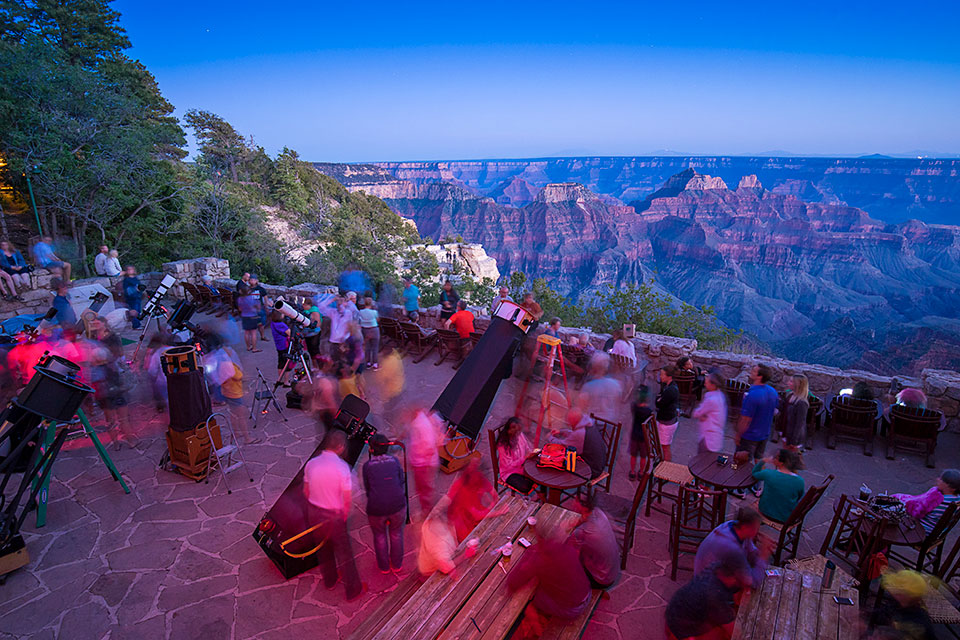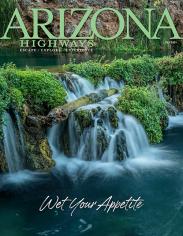When you’ve been driving for seven hours in search of a starry sky, there are a few things you don’t want to see near the end of the trip.
Clouds are one of them.
My wife, Jen, and I are approaching the North Rim of Grand Canyon National Park for the Grand Canyon Star Party, an annual event in mid-June that takes park visitors on a journey much longer than the roughly 350-mile drive from the Phoenix area. On both the North Rim and the South Rim, amateur astronomers offer up their telescopes, some of which are worth more than a secondhand Subaru, for public viewing of planets, star clusters and other wonders of the night sky. But the more remote and less developed North Rim boasts less man-made light — the technological hazard that’s increasingly blotting out the stars and sending astronomers of all skill levels, and telescopes of all sizes, to the few remaining dark corners of the modern world.
The trip is worth it to Steve Dodder, who coordinates the North Rim event for the Phoenix-based Saguaro Astronomy Club. “It’s just so much fun to see some of these first reactions to seeing the stars,” he says. “It’s a connection to what’s around us — to the rest of the universe.”
But a monsoon storm can sever that connection, I note while watching clouds gather over the Canyon as we head down State Route 67.
Dodder spent his childhood summers in Ontario, Canada. “My mother would take us up there for three weeks,” he says. “We would be in the middle of nowhere, and we could see the Milky Way and the stars so clearly. It’s visceral. We’re so isolated in our own little things — our phone apps and Twitter and whatnot — that we just don’t look at the sky anymore.” As a byproduct of what he calls “very high-quality family time,” he and his family would climb a bluff over a lake and watch the stars. The seed was planted.
Dodder hopes to do the same for Grand Canyon visitors at the Star Party, which he and his wife first attended on the South Rim in 1997. Later, after a Utah organization pulled out of the North Rim side of the event, the Saguaro Astronomy Club took over. Dodder has been coordinating since 2007.
Most of the club’s members have day jobs, but Kevin Kozel, the group’s secretary, recently retired from a long career designing roads for the Arizona Department of Transportation. Like Dodder, he developed an interest in the night sky at a young age — but his inspiration was more terrestrial than Dodder’s. “My doctor had a poster of the solar system on his wall, above the examining table,” Kozel says. “I could sit there on the table and just look right there. I thought, This is cool!”
Later, at age 11, Kozel watched the epic 1966 Leonid meteor shower from Phoenix’s Thunderbird Drive-In. “That was like watching [Operation] Desert Storm over Baghdad,” he says. “There must have been 300 or 400 at any one time.” He now owns several telescopes and enjoys getting out of the Phoenix area for a clear view of the stars. “It’s almost a spiritual thing,” he says. “It’s as enjoyable to look at as it is to watch a good movie.”
This movie, though, is in increasingly limited release. Light pollution has robbed urban areas of views of the Milky Way and other celestial wonders. In big cities like Phoenix, only the brightest constellations and planets cut through the glare.
It’s an issue where John Barentine, an advocate for a less familiar form of environmental protection, hopes to make an impact.
Barentine is director of conservation for the International Dark-Sky Association (IDA), a group founded in 1988 in Tucson and still based there. Thirty years ago, he says, people were just beginning to see light pollution as a problem — particularly in Tucson, which is near observatories on Mount Lemmon and Kitt Peak. Now, the IDA — whose mission, in Barentine’s words, is about “changing the nature of the human relationship with artificial light at night” — boasts 3,000 members worldwide, along with chapters in most states and several countries.
It’s no accident, Barentine says, that the group got its start in Arizona, which has some of the darkest skies in the contiguous United States. The IDA’s list of International Dark Sky Parks, places that feature starry nights and efforts to reduce light pollution, is only about 60 entries long, but it includes several Arizona sites, such as Grand Canyon National Park, Wupatki and Sunset Crater Volcano national monuments near Flagstaff, and Oracle and Kartchner Caverns state parks in the Tucson area. And Flagstaff, Sedona, the Village of Oak Creek and even Fountain Hills, near Phoenix, are among the IDA’s handful of International Dark Sky Communities — places where light pollution might exist, but policies are in place to keep it from getting worse.
However, the aptly named Valley of the Sun poses challenges for astronomers. “There’s now almost no corner of the state that does not see the light from Phoenix,” Barentine says. Threats to federal public lands, which often act as a “reservoir of darkness,” and the proliferation of LED billboards, which blast their light horizontally and can’t be effectively shielded, are other concerns, he says.

But the IDA believes the growing “astrotourism” industry is among many compelling reasons to save our starry nights. “People are willing to travel great distances, in some cases, to see a really dark night sky,” Barentine says. “And an astrotourist is somebody who, guaranteed, will do an overnight stay.” That could be an economic boon, he adds, in rural areas of the American West — places where “they have this resource already, and to keep it, they don’t have to do very much.”
The Canyon posed a unique challenge for the IDA, which usually honors sites with less infrastructure and fewer visitors. The South Rim, in contrast, is home to a village of around 2,000 people, and more than than 5 million others visit that side of the park every year. In partnership with the Grand Canyon Association, the park staff took inventory of the more than 5,000 lights in the park and began retrofitting them to reduce light pollution. That led to the Canyon’s 2016 provisional designation as an International Dark Sky Park, and its goal is to complete the retrofitting in time for the park’s 2019 centennial.
The sky is even darker than usual during the eight-day Grand Canyon Star Party, which is timed to coincide with June’s new moon. As I’m reminded, that’s also around the time Arizona’s stormy season begins.
This is not going well, I think. It’s approaching 10 p.m., and I’m sitting in one of the worn Adirondack chairs on the deck of Grand Canyon Lodge. It’s plenty dark for stargazing, but so far, the monsoon has clouded the view and spurred Kozel to instead point his telescope at a forest fire burning near the South Rim. And now, a light rain has begun to fall, sending a dozen astronomers scrambling to cover their sophisticated scopes — some of which are 6 to 8 feet tall.
Jen and I are tired, but I’m mostly wondering how I’m going to explain to my editor that I took an overnight trip to the North Rim to see stars that weren’t there. But then we get a gift from the monsoon gods: an opening in the clouds (Dodder calls it a “turkey hole”) through which Jupiter and a starry sky are visible. Dodder swings his 20-inch scope into action, aiming it at the solar system’s largest planet — named, appropriately for tonight, for the Roman god of thunder — and its four biggest moons.
Dodder now lives in Maricopa, south of Phoenix. He moved there before it was an incorporated city — when there was “nothing out there” and the community had an unspoiled view of the sky. Now, though, light pollution from Phoenix has marred the northern horizon. He’s advocated at city meetings for sky-friendly streetlights, but there’s only so much one person can do. That’s part of why he’s here — to get others thinking about what a night sky means to them.
“People just don’t see them anymore,” he says. “They come out here from the cities, and they see what a dark sky can really do and what you can see in it. We just hope we can reconnect somebody with that — the little ones, especially. Hopefully, they’ll push their parents to do some activism.”
Barentine echoes that sentiment but says there are other entry points — such as economic benefits, energy conservation and public health — to a discussion of why we need the darkness. And when people tell him he’s fighting a hopeless battle, he points to a battle that ended sooner than anyone expected: “When was the last time you went into a restaurant and were asked, ‘Would you like smoking or nonsmoking?’ ”
I peer into the eyepiece of Dodder’s scope and see the swirling cloud bands of Jupiter, a planet that seems wholly indifferent to the Earthbound storm vexing these stargazers. Here, at Arizona’s best-known natural wonder, we’re experiencing the wonder of a world hundreds of millions of miles away.
“Oh, wow,” I say, almost subconsciously. Despite the darkness, I can tell Dodder is smiling. “ ‘Oh, wow’ is good,” he says. “Amateur astronomers are paid by the ‘wow.’ ”

